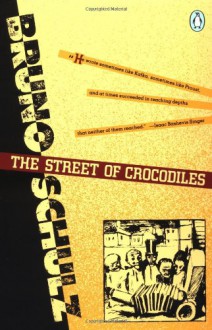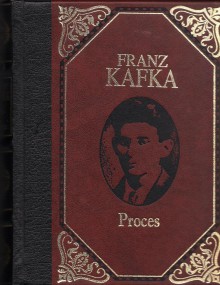
Bruno Schulz had an imagination like no one else. His metaphors, similes, and personifications whirl the reader through a cosmos as vivid and surreal as Van Gogh’s “Starry Night.” His characters prophesy like the enigmatic beings that inhabit the pages of William Blake. At once fiction and nonfiction, prose and poetry, memory and dream, The Street of Crocodiles defies categorization.
Schulz is sometimes compared to Kafka, but he should not be. He is not Kafkaesque. The world of Kafka is a nightmare world ~ a nightmare from which one cannot awaken. The world of Schulz is the real world touched by the fantastic, the real world as perceived in a dream. Nor is this magical realism, for elements of fantasy do not truly invade the real world. It is only the narrator’s perceptions which import the fantastic or the grotesque into the real.
The distortions of reality—of time and space—are distortions imposed by the mind of the observer. And the observer is the mythopoeic visionary Bruno Schulz, a man whose dream world is superimposed upon the real one, a man who is at home with the visions of prophets and madmen, a man who never quite lost the childhood ability to see behind the curtain of the mundane, to glimpse the cosmic wonders through which the mass of men and women sleepwalk. Schulz is like one who awakens in a dream.
The following passages highlight three dream elements in The Street of Crocodiles. First, there is spatial distortion.
“I stepped into a winter night bright from the illuminations of the sky. It was one of those clear nights when the starry firmament is so wide and spreads so far that it seems to be divided and broken up into a mass of separate skies, sufficient for a whole month of winter nights and providing silver and painted globes to cover all the nightly phenomena, adventures, occurrences and carnivals.
It is exceedingly thoughtless to send a young boy out on an urgent and important errand into a night like that because in its semiobscurity the streets multiply, becoming confused and interchanged. There open up, deep inside a city, reflected streets, streets which are doubles, make-believe streets. One’s imagination, bewitched and misled, creates illusory maps of the apparently familiar districts, maps in which the streets have their proper places and usual names but are provided with new and fictitious configurations by the inexhaustible inventiveness of the night...” (87-88).
Second, there is temporal distortion.
“Everyone knows that in a run of normal uneventful years that great eccentric, Time, begets sometimes other years, different, prodigal years which—like a sixth, smallest toe—grow a thirteenth freak month.
We use the word ‘freak’ deliberately, because the thirteenth month only rarely reaches maturity, and like a child conceived late in its mother’s life, it lags behind in growth; it is a hunchback month, a half-witted shoot, more tentative than real.
What is at fault is the senile intemperance of the summer, its lustful and belated spurt of vitality. It sometimes happens that August has passed, and yet the old thick trunk of summer continues by force of habit to produce and from its moldered wood grows those crab-days, weed-days, sterile and stupid, added as an afterthought; stunted, empty, useless days –white days, permanently astonished and quite unnecessary. They sprout, irregular and uneven, formless and joined like the fingers of a monster's hand, stumps folded into a fist.
There are people who liken these days to an apocrypha, put secretly between the chapters of the great book of the year; to palimpsests, covertly included between its pages; to those white, unprinted sheets on which eyes, replete with reading and the remembered shapes of words, can imagine colors and pictures, which gradually become paler and paler from the blankness of the pages, or can rest on their neutrality before continuing the quest for new adventures in new chapters” (125-126).
And last, there is the uncanny ~ the revelation of an occult world that coexists with the real world, a world hidden from all but the few whose peculiar nature allows them to discover it.
“... at that late hour the strange and most attractive shops were sometimes open, the shops which on ordinary days one tended to overlook. I used to call them cinnamon shops because of the dark paneling of their walls.
These truly noble shops, open late at night, have always been the objects of my ardent interest. Dimly lit, their dark and solemn interiors were redolent of the smell of paint, varnish and incense; of the aroma of distant countries and rare commodities. You could find in them Bengal lights, magic boxes, the stamps of long-forgotten countries, Chinese decals, indigo, calaphony from Malabar, the eggs of exotic insects, parrots, toucans, live salamanders and basilisks, mandrake roots, mechanical toys from Nuremberg, homunculi in jars, microscopes, binoculars and most especially strange and rare books, old folio volumes full of astonishing engravings and amazing stories.
I remember those old dignified merchants who served their customers with downcast eyes, in discreet silence, and who were full of wisdom and tolerance for their customers’ most secret whims. But most of all, I remember a bookshop in which I once glanced at some rare and forbidden pamphlets, the publications of secret societies lifting the veil on tantalizing and unknown mysteries” (89).
Familiar streets transformed into a marvelous labyrinth, time extending beyond its natural limits, an esoteric ‘other world’ concealed in the midst of the ordinary and everyday ~ this is the dreamy Drohobych of Schulz’s imagination, a mythic city described in rich prose that alternately drips with the golden juices of ripe fruit or scuttles mechanically on spidery legs or entices the mind with cryptic messages of mystical import.
The Street of Crocodiles is a weird and wondrous book. When Schulz was murdered at the age of fifty, shot by a Nazi soldier, the world lost a truly unique artist.

 Log in with Facebook
Log in with Facebook 











